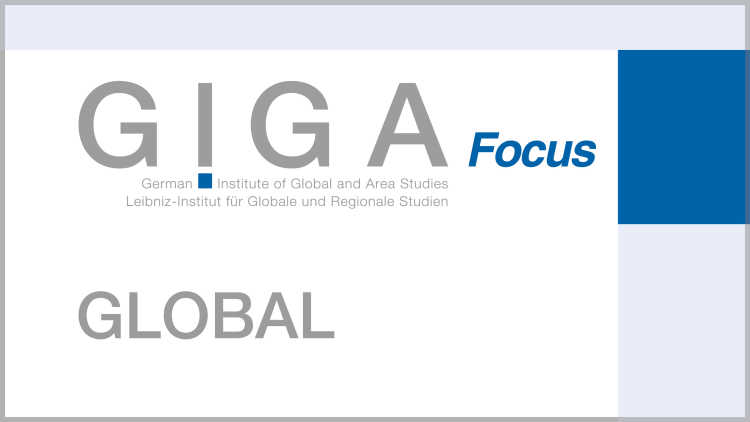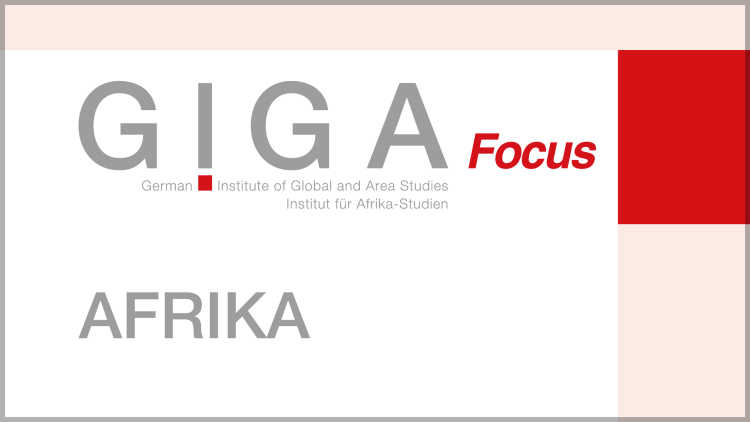- Home
- Publications
- GIGA Focus
- Aspiring by Degree: Outbound Student Migration from India to Germany
GIGA Focus Asia
Aspiring by Degree: Outbound Student Migration from India to Germany
Number 5 | 2016 | ISSN: 1862-359X

For Germany, India is the second most important source of foreign postgraduate students, after China. Student flows from India are contributing significantly to Germany’s efforts to internationalise higher education in the country and address labour market skills shortages. Understanding what is driving postgraduate student migration from India to Germany is crucial for further increasing these flows.
In India, awareness about Germany as a study destination has been growing in recent years but remains low compared to awareness regarding more traditional study destinations for Indian students, such as the USA, the UK, and Australia.
Indian students heading to Germany are attracted by the low cost of education, courses taught in English, the perceived high quality of education, the availability of paid part-time work opportunities during study, an 18-month post-study visa, and the EU Blue Card scheme, together with the perceived availability of good jobs.
Overall, the cost advantage German universities offer over universities in the USA, the UK, and Australia is the main draw for most students heading to Germany.
Engineering and information technology (IT) courses are the most popular among Indian students in Germany, with the vast majority of these students enrolled on such courses.
Students first encounter the possibility of study in Germany through their social networks or private education consultancies, both of which – along with social media sites – serve as important conduits of information and support to aspirant student migrants to Germany.
Policy Implications
To benefit from rising Indian student flows to Europe, the cost advantage of German universities must be preserved. Also, students should be given more opportunities to directly interact with representatives of German universities, as education consultancies have limited incentives to recommend study in Germany. The value of embarking on courses other than engineering should be demonstrated.
The Growing Significance of Indian Student Flows to Germany
In the last 15 years, India has seen a sharp rise of 228 per cent in the number of students traveling abroad for university education – most commonly, postgraduate degrees (UIS 2013) – making it the second most important source of outbound postgraduate students after China (British Council 2014). A British Council study (2014) forecast that between 2012 and 2024 India would be the fastest growing source of outbound postgraduate students worldwide, with the number of students expected to rise from 88,000 to 209,000. While the USA, Australia, and the UK remain the most preferred host countries for Indian students, over the last 10 years a new set of study destinations – for instance, Germany – have gained increasing prominence in the imaginations of aspirant student migrants and are witnessing rising flows of Indian students.
The number of Indian students in Germany has almost tripled in the last five years. In 2014–2015, a total of 11,860 Indian students were studying in Germany (Bruder et al. 2015). Germany is currently the fifth most popular study destination for Indian students, after the USA, Australia, the UK, and Canada, and thus the most popular non-English-speaking country to which Indian students travel. For Germany, India is now the second most important source of international students at the postgraduate level after China, and the single largest source of students who study engineering and information technology at the postgraduate level. Between 2012 and 2024, Germany’s popularity as a study destination is predicted to increase significantly among Indian students, and it is estimated that India will account for 27 per cent of the total inbound postgraduate growth, followed by China, which will account for 18 per cent of this growth (British Council 2014). Indeed, during this period the increase in Indian student flows to Germany (10,000) is estimated to be greater than that to the UK (7,000) (ibid.).
In 2013, the newly formed German government, in their coalition treaty, pledged to increase the number of foreign students in the country by 25 per cent to 350,000 by 2020, as part of a larger strategy to internationalise higher education and research in Germany (CDU, CSU, and SPD 2013). Increased flows of international students can also help the country meet another objective: attracting highly skilled workers to enter its labour market. Germany’s diminishing demographic trend means that the country is faced with a shortage of skilled labour (particularly qualified engineers, scientists, information technology specialists, and health specialists). According to the Federal Labour Agency, by 2030 there is likely to be a shortage of almost six million workers. Efforts to close the skills gap include the passing of legislation to facilitate the transition of non-EU graduates of German universities – increasingly viewed as “ideal” immigrants, given their credentials and experience in Germany – into the country’s job market (The Expert Council 2015). In 2012, following the EU Directive 2009/50/EC, Germany implemented the EU Blue Card scheme, which makes it easier and more attractive for third-country nationals to obtain a residence and work permit in Germany (cf. Gereke 2013; Wogart & Schüller 2011). With the introduction of the EU Blue Card, certain other changes were made to the German Residence Act – most importantly, the increasing of part-time work possibilities and of the time period after graduation during which students may remain in Germany to search for a suitable job (Gereke 2013).
This paper examines how these measures have been received by aspirant Indian student migrants and analyses the main drivers of transnational student flows from India to Germany. It also explores how Indian students navigate the process of applying to German universities. Based on the findings, the paper offers some recommendations for German policymakers and universities, as well as for the German Academic Exchange Service (DAAD).
The paper draws on fieldwork carried out in the south Indian city of Bangalore. Over the last two decades Bangalore has gained iconic status as the “Silicon Valley of India” because of the growth and success of its IT industry. It is also a key “base” city for out-migration and home to a robust industry of private education consultancy firms, which offer aspirant student migrants assistance with all aspects of the application process to foreign universities. Such consultancies have proliferated across India in the last 15 years, with hundreds of centres now present in every big city. Interviews were conducted with proprietors of education consultancies in Bangalore, the local DAAD Information Point, students applying for postgraduate degrees in Germany without the support of an education consultancy, and students who had completed a postgraduate degree in Germany. Furthermore, data were collected from the websites of education consultancies, Facebook groups and Internet forums created by Indian students in Germany or Indians aspiring to study in Germany, and the websites and promotional material of foreign universities, as well as during events (educational fairs, pre-departure briefings) organised by education consultancies for students embarking on study abroad.
Europe as an Increasingly Popular Destination among Indian Students
As macro-level studies have suggested, the dramatic rise in transnational student migration from India can be attributed to both economic and demographic factors (e.g. British Council 2014). The liberalisation of the Indian economy and the new employment and mobility opportunities it has brought in its wake have given rise to a new middle class which is steadily expanding as India’s GDP increases. With a growing number of people who have the means and desire to invest in university education – and the fact that 50 per cent of Indians are below the age of 25 – the demand for tertiary education in the country has risen sharply. Although India has seen a mushrooming of colleges and universities at different fee levels to suit a range of middle-class incomes, only a small percentage of these are nationally reputed. Consequently, the competition to gain admission to such prestigious universities is fierce. With the internationalisation of higher education, studying abroad has emerged as a realisable educational strategy amongst the new middle classes.
The traditional study destinations for Indian students have long been English-speaking countries, particularly the USA, the UK, and Australia. However, as noted already, over the last decade a new set of countries – particularly European countries, ranging from Germany and the Netherlands to Latvia and Lithuania – have gained increasing popularity among Indian students. Universities from many of these countries have been making efforts to attract international students, and a number have started to partner with education consultancies in India. In their promotional material, certain things are commonly stressed: the availability of high-quality education at a considerably lower cost than in the USA, the UK, etc.; the availability of courses taught in English; the “international” atmosphere of the universities and content of the courses offered; and, in some cases, internship and post-study work opportunities. Universities in Central and Eastern Europe are likely to stress additionally that they offer “European degrees” that are recognised internationally, and one of the selling points made by the Indian consultancies representing them is that students studying at such universities can travel to other Schengen countries and, in some cases, get post-study work visas that lead to EU residence permits.
The majority of Indian students who are planning to study abroad have very little familiarity with most of these European countries. Indeed, consultants said that a number of students had not even heard of the countries to which they were applying before they had begun exploring possible study destinations abroad. Germany is, in comparison, well known, and is by far the most popular of the European countries. Consultants said that in the last 15 years an increasing number of students had been approaching them specifically about study in Germany.
Nevertheless, compared to the USA, the UK, Australia, and even New Zealand and Canada, the level of awareness about Germany as a study destination is still low. Furthermore, those who are considering study in Germany still have a number of concerns. These concerns revolve around whether German degrees are recognised internationally (particularly in the USA and India); whether the pedagogical practices used in German universities are similar to those used in the USA and the UK; how “international” German universities are in terms of student composition; and whether Indian students in Germany are able to integrate well into everyday life both within and outside the university.
Drivers of Transnational Student Migration from India to Germany
Despite these concerns, Germany is regarded as an attractive study destination for a number of reasons. Firstly, the relatively low cost of a postgraduate degree is what initially attracts most students to the possibility of study in the country. With the annual fees at US and UK universities being several times the average annual income of a middle-class Indian, study in Germany is perceived by many as an affordable route to an international education.
Secondly, Germany offers a large number of postgraduate courses taught in English, ranking second after the Netherlands in terms of the absolute number of such courses offered (848 and 1,007 respectively) (Bruder et. al. 2015: 139). Most students said they would have been unlikely to consider Germany as a study destination if universities only offered German-taught postgraduate courses. Nevertheless, students are not opposed to learning German. They hear from both consultants and people in their social networks studying in Germany that some proficiency in German is important in order to live comfortably in the country, and essential to improve one’s job prospects. This is not perceived as a deterrent. Indeed, many students are happy to do an A1 or even A2 German language course prior to their departure. Courses at the Goethe Institute are very popular, but are often fully booked for months. In response to the demand for German language instruction, a number of consultancies have begun to offer their own German classes, and many private language training institutes have also begun teaching German (in addition to English and French). Consultants said that it was easier to gain admission to courses at German universities that were partly taught in German, and a small proportion of students who were concerned that they might not gain admission to their preferred course of study taught in English were even happy to take intensive German lessons in order to be able to apply for such bilingual courses.
Thirdly, the perceived quality of German universities makes study in Germany desirable. Germany is regarded as an “engineering hub” and an especially good place to study for engineering degrees (particularly mechanical engineering or automobile engineering) and information technology (IT) degrees. Of the total number of Indians in Germany, 54 per cent are enrolled on an engineering degree programme. Another 30 per cent are enrolled on courses in the fields of IT, mathematics, and the natural sciences. This is in keeping with the wider trend of a preference for engin-eering among foreign students in Germany (Bruder et. al. 2015: 136). State-funded German universities are competitive and not easy to gain admission into, and this adds to the prestige of embarking on a degree in Germany. Some of the students interviewed described how their decisions to study in Germany had also been influenced by the availability of specialised engineering courses not available in the USA or the UK. For instance, one of the students, who was enrolled on a course in embedded systems engineering, said that US universities only offered a master’s in electrical engineering with a major in her area of embedded systems.
Fourthly, the availability of paid work and internship opportunities during the course of one’s study is an important consideration for many students deciding on which country to go to for study. In Germany, not only are students permitted to work for 120 full days or 240 half days per year alongside their studies (up from 90 full days prior to 2012), but consultants and students also said that they had heard from students studying in Germany that internships and research assistantships are very well paid. The students interviewed, who had completed master’s programmes in engineering (at different universities), said that the research assistantships they had been able to get had been so well paid that they had needed to ask their parents for very little financial support. Students considering applying to Germany hear about such experiences through their social networks and also on social media sites.
Finally, the favourable post-study work possibilities that Germany offers constitute a huge “pull” factor. While some view study abroad as a path to full emigration, the vast majority go abroad intending to work there for at least some years. With the UK’s cancellation of its post-master’s work visa scheme in 2012 (UK Home Office 2012), there has been a dramatic fall in interest in the UK’s higher education market. That same year, Germany extended the period of time that non-EU students can remain in the country after graduation to search for a job from 12 months to 18 months (longer than the permitted period in most other European countries). In 2012, the German parliament also passed the EU Blue Card directive. The EU Blue Card is a residence and work permit, which has made it easier for highly skilled migrants from outside the EU to live and work in Germany. With the launch of the EU Blue Card in Germany, the income requirements for highly skilled foreign workers who wish to work in the country have been lowered (from EUR 66,000 to EUR 49,600, or EUR 38,688 for professions in the shortage list), and firms may hire such workers without conducting a labour market test. The card offers a number of other benefits, including salary and work conditions equivalent to those of EU nationals, entitlement to socio-economic rights such as social security, family reunification rights, and the possibility of applying for permanent residence in as little as two years. Together, these visa schemes have caused aspirant Indian student migrants to Germany to see post-study employment in the country as a feasible and attractive possibility.
Germany is widely regarded as offering excellent work prospects, especially in the fields of engineering and IT, which are on Germany’s skills-shortage list. While the US job market is also regarded as offering extensive opportunities, work prospects in the UK are thought to be bleak. Consultants described cases of Indian engineers who had completed a postgraduate degree in the UK but were unable to find a job there and had then embarked on an additional degree in Germany, hoping that this would allow them to compete better in the German job market. They also said that students who had a bachelor’s degree in a field of engineering other than software engineering often struggled to get jobs in their fields in India, given the country’s ongoing software boom. Many were forced to join software companies and work as software engineers. It is felt that in Germany engineers would have a better chance of finding work suited to their training.
Students imagine that a master’s degree in Germany will make it easier for them to access the German job market and improve their ability to compete in it. It should be noted that the possibility of study in Germany is what first attracts students to the possibility of working in the country. No one reported having considered investigating employment opportunities in Germany prior to becoming interested in the country as a study destination. Of the 8,879 Blue Cards that were issued between August 2012 and June 2013, approximately 70 per cent were issued to non-EU nationals who had lived in Germany previously, most of whom had graduated from a German university (Gereke 2013). Thus, it appears that the EU Blue Card has been received more positively – at least by Indian student migrants to Germany – than Wogart and Schüller (2011) predicted.
Nevertheless, most people are happy to study in Germany only if they do not have to pay tuition fees. Students who are only able to gain admission to paid courses in Germany often decide to go to the USA, even if it means raising more money. With over 4,000 universities, one of the two largest economies in the world, and a long history as the “mecca” of foreign study for Indian students, the USA still holds the top place in most students’ minds in terms of educational quality and opportunities. Students also feel that they will be able to more easily integrate and succeed in a country in which English – a known language – is the main language of operation. Thus, although students who go to Germany view it as an attractive study destination for all the reasons outlined above, it is regarded as mainly an excellent second choice to the USA.
Navigating the Process of Applying to German Universities
In addition to the websites of German universities, the DAAD, and education consultancies, social networks and social media are credited by consultants as increasingly playing a key role in students’ foreign-study-related plans. Particularly because Germany and its education system are relatively unfamiliar terrain to most Indians, Indian students studying in Germany have become important conduits of information about the quality of education in Germany, the application process, the likelihood of gaining admission at various universities, internship opportunities, longer-term work prospects, Germany’s post-study work visa and the EU Blue Card scheme, finding accommodation, life in Germany, and so on. Students considering going to Germany seek out information on these topics through their existing social networks (college alumni/friends of friends who have studied/are studying in Germany), and on various social media sites. For instance, considerable peer-to-peer information dissemination on these subjects takes place on the question-answer website Quora.com and on Facebook pages created by/for Indian students in Germany or Indian students applying to specific German universities/courses.
Most students discover the DAAD only after they begin to research study in Germany on the Internet, and its website is widely referred to. However, the DAAD does not appear to play a major role in drawing students’ attention to Germany as a study destination. Rather, most students said that they first encountered the possibility of study in Germany through their social networks, or through education consultancies. In addition to an office in Delhi, there are DAAD Information Points or Information Centres in Bangalore, Chennai, Mumbai, and Pune. The Information Point in Bangalore, set up in 2012, organises information sessions at colleges in the city, as well as webinars, on study and research in Germany. It receives approximately 150 telephone inquiries per month, according to its manager. Most inquiries are responded to on the phone or via e-mail, and appointments are given only in cases where it is felt that further counselling is needed. Students approaching the DAAD Information Point are often under the impression that it offers for free the kind of services that education consultancies offer for a fee (described below). Consultants said that many were disappointed when the Information Point directed them to various sources of information about study in Germany, given that what most struggled with was understanding and navigating this information. Many of those students who report being happy with the guidance provided at the Information Point still felt the need to approach an education consultancy for further support. Education consultancies are an India-wide industry, and a major route through which people go abroad for study. Education consultants estimate that there are 150–300 consultancies in Bangalore alone. Some of these consultancies are national-level operators, with offices across India, while others are much smaller players. The largest consultancies report sending 800–1,000 students abroad per year, while some of the smallest report sending 50–100. “When applying to go abroad,” one consultant observed, “people feel their entire life is at stake. They want someone to hold their hand and take them through the entire procedure.”
Consultancies facilitate and shape student flows in important ways. Consultants said that a lot of their clients are initially uncertain about not just which country they wish to study in, but also the course that they want to do. Consultancies help “profile” students by conducting personality and aptitude tests, and provide students and their families with information about different countries and their edu-cation systems, job markets, and visa regulations; the types of courses available at different universities and the tuition fees they charge; and sources of funding. They then shortlist countries, universities, and courses for students, given the students’ interests, academic record, future plans, and finances. In addition, consultancies “manage” a student’s application process from start to end. They instruct students on which standardised tests they need to take (and sometimes even register them for these tests and provide them with preparatory training), offer guidance and editorial assistance with the preparation of all application documents (particularly the statement of purpose), and help them prepare their visa applications and even obtain bank loans. Finally, consultancies connect their clients to networks of people who are studying in the countries/universities they are considering as possible study destinations, who provide much-valued advice and feedback based on their own experiences. Consultancies have thus become “one-stop shops” for all things foreign-study related, attracting large numbers of aspirant student migrants.
The vast majority of consultancies partner with foreign universities and receive a commission for every student they recruit. Given that tuition fees for international students are very high (and considerably higher than the fees paid by “home students”) at universities in most study destinations, many universities are willing to offer consultancies substantial incentives to increase student flows (one consultant told me that she received a minimum of EUR 1,300 for every student she recruited for her UK partner universities). Consultants offer their services free to students interested in applying to their partner universities, but charge students a fee if they wish to apply to other universities (usually a flat rate of approximately EUR 500 for applications to five universities/courses). Reflecting and facilitating a growing interest in studying in countries outside of the traditional choices for Indian students, an increasing number of these centres are partnering with universities in Europe (from Sweden, France, and Italy to Lithuania and Latvia), as well as with universities in Singapore and China, among other countries. A few consultancies are partnered with German private universities (which charge fees and have a financial incentive to partner with consultancies), but none with state-funded ones (which are attended by the majority of Indian students in Germany). There are also a small proportion of consultancies that do not enter into partnerships with universities and always charge students a fee for their services.
While those consultancies which partner with foreign universities do assist – for a fee – those students who wish to apply to state-funded German universities, it could be argued that they are not likely to proactively recommend study in Germany to their clients as it is against their business interests; the commissions they receive from their partner universities far exceed the fee students pay to make applications to Germany. Nevertheless, the proprietor of one such consultancy reported that she had sent 300 students to Germany the previous year. She said that about half of these students had approached her with an interest in Germany, but she had suggested Germany as an option to the other half, who were engineers with excellent academic records but whose financial position made studying in the USA a difficult option. The impact of educational consultancies on student flows to Germany is thus likely to be mixed.
Given that state-funded German universities charge low to no fees and their goal is not to merely increase student flows but rather to attract the best talent, it does not make sense to attempt to follow countries such as the USA, the UK, and Australia and promote study in Germany by entering into partnerships with education consultancies. It also would not be cost-effective to attempt to replicate the service offered by such consultancies. Instead, efforts should be focused on raising awareness and disseminating information about study, work, and life in Germany, in a cost-effective yet powerful manner.
Towards Increasing Indian Student Flows to Germany
In order to realise the goals of internationalising higher education and research and to attract more highly skilled workers, German policymakers and universities have a number of options for better targeting Indian students.
As interviews with Indian education consultancies have shown, their incentives to partner with German state-funded universities and to recommend Germany as a study destination are very limited. Therefore, given most students’ lack of familiarity with Germany as a study destination, it is important that they be given opportunities to interact directly with staff from German universities (and not just the DAAD India staff). Skype seminars (e.g. with the staff of specific universities, or with staff from the engineering faculties of a number of universities) would be a cost-effective way of enabling this, and could be held at the network of Goethe Institutes across the country and coordinated by the DAAD.
If there is an interest in attracting students from a wider range of disciplinary backgrounds – particularly those in mathematics and the natural sciences, which are also on the skills-shortage list – and thus internationalising a wider range of postgraduate courses, efforts need to be made to advertise courses offered in these disciplines, and the job prospects open to those who have completed them. Once again, this could be done through Skype seminars. German universities have a very limited presence at educational fairs in India, and efforts should be made for more universities to participate in such fairs and interact directly with students. These measures will go a long way towards increasing the visibility of Germany as a study destination in India, and facilitating impactful information dissemination about study, work, and life in the country.
If the cost advantage of higher education in Germany is removed, the other “pull” factors attracting students might not be adequate to maintain Germany’s popularity as a study destination. Preserving this cost advantage is crucial to maintaining and increasing student flows from India. Furthermore, based on the experience of the UK, if foreign students’ post-study work opportunities are altered unfavourably, this is also very likely to negatively impact student flows to Germany.
Footnotes
References
British Council (2014), Postgraduate Student Mobility Trends to 2024, www.britishcouncil.org/sites/default/files/postgraduate_mobility_trends_2024-october-14.pdf (8 July 2016).
Bruder, Martin, Simone Burkhart, Barbara Franke, Ulrich Heublein, and Jan Kercher (2015), Wissenschaft weltoffen: Daten und Fakten zur Internationalität von Studium und Forschung in Deutschland. Schwerpunkt: Internationale Masterstudierende an deutschen Hochschulen, www.wissenschaftweltoffen.de/publikation/wiwe_2015_verlinkt.pdf (8 July 2016).
CDU, CSU, and SPD (2013), Deutschlands Zukunft gestalten, https://www.bundesregierung.de/Content/DE/_Anlagen/2013/2013-12-17-koalitionsvertrag.pdf;jsessionid=CF9C68A9EF5D0C8A28F02D0A71C90095.s6t1?__blob=publicationFile&v=2 (8 July 2016).
Gereke, Johanna (2013), Highly-Skilled Indian Migrants in Germany, CARIM-India RR2013/32, www.india-eu-migration.eu/media/CARIM-India-HSM-2013-32.pdf (8 July 2016).
Mukherjee, Shahana, and Rupa Chanda (2012), Indian Student Mobility to Selected European Countries – An Overview, IIM Bangalore Research Paper, 365, http://papers.ssrn.com/sol3/papers.cfm?abstract_id=2116198 (8 July 2016).
The Expert Council of German Foundations on Integration and Migration (Sachverständigenrat deutscher Stiftungen für Integration und Migration) (2015), Train and Retain: Career Support for International Students in Canada, Germany, the Netherlands and Sweden, www.svr-migration.de/wp-content/uploads/2015/08/Study_Train-and-Retain_SVR-research-unit_WEB.pdf (8 July 2016).
UK Home Office (2012), Statement of Intent, www.gov.uk/government/uploads/system/uploads/attachment_data/file/117974/changes-study-visa-soi.pdf (8 July 2016).
UNESCO Institute for Statistics (UIS.Stat) (2016), Education: Outbound Internationally Mobile Students by Host Region, http://data.uis.unesco.org/Index.aspx?queryid=172 (8 July 2016).
Wogart, Jan, and Margot Schüller (2011), The EU’s Blue Card: Will It Attract Asia’s Highly Skilled?, GIGA Focus International Edition, 3, Hamburg: GIGA, www.giga-hamburg.de/en/publication/the-eus-blue-card-will-it-attract-asias-highly-skilled (8 July 2016).
General Editor GIGA Focus
Editor GIGA Focus Asia
Editorial Department GIGA Focus Asia
Regional Institutes
How to cite this article
Jayadeva, Sazana (2016), Aspiring by Degree: Outbound Student Migration from India to Germany, GIGA Focus Asia, 5, Hamburg: German Institute for Global and Area Studies (GIGA), http://nbn-resolving.de/urn:nbn:de:0168-ssoar-48182-7
Imprint
The GIGA Focus is an Open Access publication and can be read on the Internet and downloaded free of charge at www.giga-hamburg.de/en/publications/giga-focus. According to the conditions of the Creative-Commons license Attribution-No Derivative Works 3.0, this publication may be freely duplicated, circulated, and made accessible to the public. The particular conditions include the correct indication of the initial publication as GIGA Focus and no changes in or abbreviation of texts.
The German Institute for Global and Area Studies (GIGA) – Leibniz-Institut für Globale und Regionale Studien in Hamburg publishes the Focus series on Africa, Asia, Latin America, the Middle East and global issues. The GIGA Focus is edited and published by the GIGA. The views and opinions expressed are solely those of the authors and do not necessarily reflect those of the institute. Authors alone are responsible for the content of their articles. GIGA and the authors cannot be held liable for any errors and omissions, or for any consequences arising from the use of the information provided.















